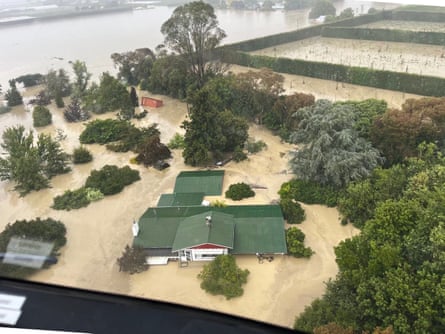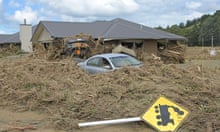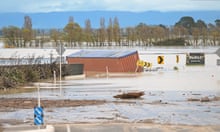There are grave concerns for several people who remain missing after severe storms in New Zealand, as Cyclone Gabrielle moves away from the country, leaving behind widespread damage, more than 10,000 displaced and at least four dead, including one child.
Police have received more than 1,440 reports of missing people, and while they expect many of those people to be found, the prime minister, Chris Hipkins, said on Wednesday evening “there are several people missing for whom the police do hold grave concerns”.
On Wednesday afternoon a child’s body was found in Eskdale, Hawke’s Bay. They are believed to have been caught in rising water yesterday, police said.
The prime minister acknowledged those who had lost loved ones, saying: “The grief of their families would be unimaginable.”
The search and rescue efforts came as Wellington recorded an earthquake on Wednesday evening. Initial reports measured it as a magnitude 6.2 quake but at a depth of 80km. There were no immediate reports of damage.
Some parts of the North Island remained cut off from all access, power and communications, making assessing the damage or reaching those in need difficult.
Roads and homes have been submerged by flooding, while key state highways have been cut off by landslides and road collapse. Power was restored to about 80,000 households overnight, but an estimated 160,000 remained without power on Wednesday evening. As of 2.30pm on Wednesday, 1,442 people had been reported uncontactable to police.
At least three people have died in the Hawke’s Bay area; one woman who was killed after a landslide crushed her home, another person who was found dead on the shoreline, and the child found in Esk Valley.
On Wednesday evening at least seven rescue missions were under way in the region, where hundreds of people had already been rescued from rooftops after flooding rose to inundate their homes. “In some cases, flood waters were up to the second story of homes where people were being rescued,” the defence force said in a statement.
The emergency management minister, Kieran McAnulty, said it would be unsurprising if the death toll in the region rose further.
“It wouldn’t surprise me,” he said. “Obviously we hope that doesn’t happen.”

In Muriwai, Auckland, the body of a firefighter was found after two days of searching. He had been missing after a landslide destroyed the house that emergency services were checking.
With an estimated 10,500 displaced, the government is bracing for a huge influx of people needing emergency or ongoing accommodation.
Given the number of regions that remain uncontactable across the North Island, that figure is expected to rise. The number of people injured, and homes destroyed, remains unknown.
“We are very aware that this is the largest emergency housing project that the country will have ever had to undertake,” the housing minister, Megan Woods, said. “This will be a larger job than the Christchurch earthquake and that was not insignificant.”
Concern is growing for areas of the North Island with limited communications or power, where authorities have little or no information on the welfare of small settlements and rural residents.
The town of Wairoa in the Hawke’s Bay region, home to about 8,600, had been a communications blackspot on Tuesday, with all access and telecommunications down.
A civil defence team in the town dispatched a message via satellite phone in the early hours of Wednesday, saying: “We are managing but we are geographically isolated and facing severe challenges. These include food and water supply, fuel and communications. We are working to ensure people’s safety.”
They said the town had only one day’s worth of food and two of drinking water.
The damage to New Zealand’s transport network is extensive, with many key arterial routes cut off by slips or collapse.
In the Coromandel, McAnulty said access was extremely limited, with the region “absolutely pelted”.
The arterial state highway had collapsed, he said, and “the road network, both state highways and local roads, has been decimated with slips”.

In Northland, the country’s northernmost region, access was also extremely limited, with landslides cutting off most of the state highways. As of Tuesday night, Waka Kotahi NZ Transport Agency classed both regions as “isolated … with all major arterial roads still closed”.
The government continued to urge New Zealanders to evacuate if needed and avoid unnecessary travel.
“If it’s safe to stay and you don’t need to go, if you’ve got the provisions, hunker down, look after each other,” McAnulty said. “It will be OK. It will clear.”








